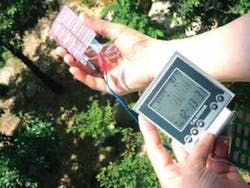ORGANIC PHOTOVOLTAICS: Inverted tandem structure boosts efficiency of organic solar cells
By inverting the typical tandem solar-cell structure and inserting a transparent barrier layer, a team of scientists led by Nobel Laureate Alan Heeger at the University of California-Santa Barbara and Kwanghee Lee at the Gwangju Institute of Science and Technology (Gwangju, Korea) has boosted the power-conversion efficiencies of semiconductor polymer solar cells to 6.5%.1
Seven years ago, Heeger shared the Nobel Prize in chemistry with Alan MacDiarmid and Hideki Shirakawa for the discovery and development of conducting polymers. He cofounded Konarka Technologies (Lowell, MA) to develop and market organic photovoltaic solar cells based on the new materials.
“This is the highest level achieved for solar cells made from organic materials,” Heeger said of the 6.5% conversion efficiency. “I am confident that we can make additional improvements that will yield efficiencies sufficiently high for commercial products.” He added that he believes the technology, which he expects will be on the market in about three years, will contribute to Third World usage of technologies such as laptop computers, in areas that do not depend upon connection to an electricity grid.
The semiconducting polymer-fullerene composites developed by Heeger, Lee, and colleagues offer potential for fabrication of large-area, solid-state organic solar cells. Ease of processing from solution on a variety of substrates would enable the active materials to be patterned over large areas on a variety of substrates using low-cost printing and coating technologies. Conversion efficiency remains a primary area of concern, however, and considerable research is focused on improving three parameters that determine the energy conversion efficiency of a solar cell: the open-circuit voltage, the short-circuit current, and the fill factor.2
Two cells in series
Tandem cells can improve efficiency in organic, inorganic, and hybrid PV materials, because they enable collection of a broader light spectrum. A wide-bandgap and a narrow-bandgap material are stacked in such a way that sunlight falls first on the wide-bandgap material, which absorbs high energy solar photons. However, the wide-bandgap material remains transparent to lower energy photons that pass through to be absorbed in the narrow-bandgap material. A semitransparent metal layer normally separates the two cells.
In the polymer-fullerene composite PV material developed by Heeger, Lee, and colleagues, the primary effect upon exposure to solar light is a photoinduced electron transfer between semiconducting polymer donor- and fullerene acceptor-type molecules, yielding a charge-separated state. In developing and optimizing a tandem solar cell consisting of wide-bandgap and narrow-bandgap polymer-fullerene subcells, the researchers tried more than 200 variations of the tandem cell architecture: changing the order of the active materials, varying the concentration and ratio of each component in the composite solutions, and varying the thicknesses of the two bulk heterojunction materials.
They found that the highest efficiencies were achieved by inverting the tandem-cell structure to place the narrow-bandgap polymer-fullerene at the front and the wide-bandgap material at the rear, and also by replacing the semitransparent metallic layer between the cells with a fully transparent titanium oxide layer used to separate and connect the front cell and the back cell. The inverted structure enabled the researchers to significantly improve both the short-circuit current of the tandem device and the photocurrent between the two cells, thereby achieving a 30% improvement over 5% efficiency levels of single polymer-composite solar cells.
In tandem cells, the front cell is made thinner than the back cell to balance photocurrents in the two cells, but the narrow-bandgap polymer-fullerene composite in the Santa Barbara research had to be kept thin to maintain acceptable levels of short-circuit current and fill factor. The wide-bandgap material had no such limitations, however, so inverting the positions of the materials and using a fully transparent layer between them provided the necessary photocurrent balance.
The transparent titanium oxide layer also serves as an electron-transport and collecting layer for the first cell, and as a stable foundation that enabled the fabrication of the second cell to complete the tandem cell architecture. Simplicity of the fabrication process is also maintained because the transparent layer, like both cells, is deposited from solution (through sol-gel chemistry).
REFERENCES
1. J.Y. Kim et al., Science 317, 222 (July 13, 2007).
2. R.A.J. Janssen et al., MRS Bulletin30, 33 (January 2005).
Hassaun A. Jones-Bey | Senior Editor and Freelance Writer
Hassaun A. Jones-Bey was a senior editor and then freelance writer for Laser Focus World.
